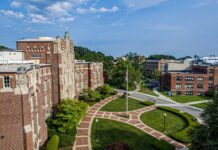PROVIDENCE — An independent analysis of promising economic clusters for Providence to nurture has identified five stars: life sciences, food processing and packaging, social enterprise, design coupled with advanced manufacturing, and education technology.
The economic development cluster strategy, released in draft form on Wednesday, had been a key recommendation of the Providence Economic Development Task Force in 2014.
The report, authored by Pittsburgh-based Fourth Economy Consulting, was discussed generally at a meeting of the Providence City Council.
The report and underlying research attempt to isolate economic segments, including clusters of related industries, that have potential to both grow in Providence and produce high-paying jobs.
“We’re leaving no stone unturned in trying to find a way to make Providence’s economy more vibrant,” said Council President Luis A. Aponte.
According to Fourth Economy President Richard Overmoyer, the data indicates that Providence is losing young workers, those under 29, as well as those aged 30 to 54, in part because the city lacks adequate housing options for people who earn between $50,000 and $100,000 annually.
The city is developing a commuter culture, instead, he said, in which increased numbers of Providence job-holders are traveling into the city from homes outside its boundaries. Seventy-eight percent of the city’s workforce, or 86,899 people, commute in from outside Providence.
In describing promising economic clusters, the Fourth Economy team identified information technology, digital media and advanced manufacturing as “opportunity sectors,” in that they employ more than 10 percent of city residents and represent an opportunity for growth.
Emerging sub-sectors, which are smaller, but have larger wage levels worth promoting, include life sciences, design, education technology, food and social enterprise, he said.
The food cluster, which he defined as food processing, packaging and sales, is a focus because local businesses added 785 jobs in these areas between 2009 and 2013, Overmoyer said. Rhode Island is leading the country in percentage of new farms being created, and in creation of organic farms. An opportunity for shared packing facilities exists, particularly for one that is certified as organic that could serve all of Rhode Island and the region.
“It’s a real opportunity to get something started,” he said.
Education technology, which is the merger of technology and software that integrates tech into classrooms, is another opportunity center, according to the report. Estimates suggest it could support up to 1,000 jobs in the Providence area, with a total market of $43 billion in 2015, the draft report stated.
The Social Enterprise Greenhouse, already located in Providence, has a national reputation, he reported, and represents another cluster to cultivate, that is, the enterprises that have a social mission of nonprofits, but operate with the market-driven approach of a business.
Life sciences, and research and development remain small in Providence, representing 93 firms and fewer than 2,000 employees, according to the report, but they have potential for growth.
The design and advanced manufacturing segments also are a cluster worth promoting, he said, noting that Providence has the nation’s third-highest concentration of industrial designers. The industry driver is engineering services, which added 31 jobs in Providence between 2009 and 2013.












